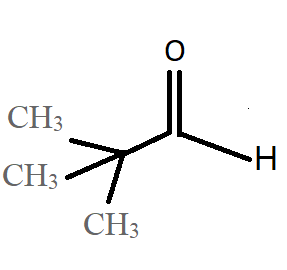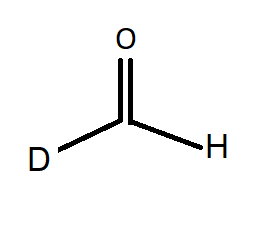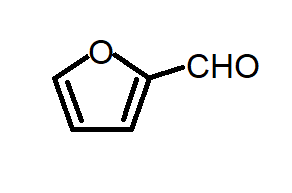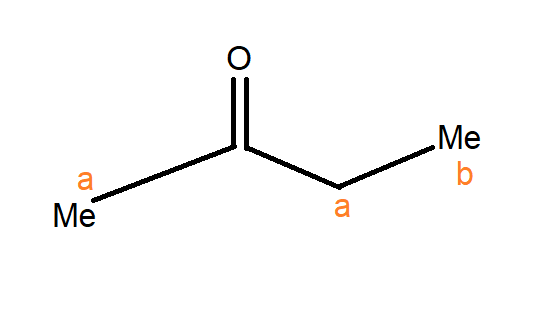
Which of the following compounds can give a cannizzaro reaction?
A.

B.

C.

D. All of the above
Answer
221.1k+ views
Hint: Cannizaro reaction is a disproportionation reaction which involves aldehyde with no alpha hydrogen as the reactant. The aldehyde group oxidises and reduces itself to give primary alcohol and a carboxylic acid as major products. Cannizaro reaction takes place in presence of a strong base like $NaOH$followed by \[{H^ + }\]. Cross Cannizaro reaction is not an example of disproportionation but a redox reaction
Complete Step by Step Solution:
Option A: trimethylacetaldehyde or also known as pivalaldehyde has formula \[{C_5}{H_{10}}O\]. Aldehyde group has hydrogen on one side and trimethyl on the other hence, there is no alpha hydrogen. Thus, the product can undergo Cannizaro reaction to form trimethyl acetic acid and 1.1-dimethyl ethanol.
Option B: formaldehyde has chemical formula $HCHO$. Formaldehyde has no alpha hydrogen hence undergoes Cannizaro reaction. If one of the hydrogen is replaced by deuterium then it has no effect on the reaction. Hence the given compound also gives Cannizaro reaction.
Option C: the given compound is known as furfural which is an aldehyde group substituted at the $2$ position of furan. Furfural undergoes Cannizaro reaction and gives furoic acid and furfuryl alcohol as major products.
Option D: thus, all the given compounds give Cannizaro because of absence of any alpha position. So, the correct answer is D.
Note: In the figure below there are two positions from aldehyde group $C = 0$ marked as a and b. The position adjacent to the aldehyde group marked as ‘a’ is known as the alpha position. The next position marked as ‘b’ is known as beta position. Thus, the number of alpha hydrogen in the compound is $5$ and $3$ beta hydrogen.

Complete Step by Step Solution:
Option A: trimethylacetaldehyde or also known as pivalaldehyde has formula \[{C_5}{H_{10}}O\]. Aldehyde group has hydrogen on one side and trimethyl on the other hence, there is no alpha hydrogen. Thus, the product can undergo Cannizaro reaction to form trimethyl acetic acid and 1.1-dimethyl ethanol.
Option B: formaldehyde has chemical formula $HCHO$. Formaldehyde has no alpha hydrogen hence undergoes Cannizaro reaction. If one of the hydrogen is replaced by deuterium then it has no effect on the reaction. Hence the given compound also gives Cannizaro reaction.
Option C: the given compound is known as furfural which is an aldehyde group substituted at the $2$ position of furan. Furfural undergoes Cannizaro reaction and gives furoic acid and furfuryl alcohol as major products.
Option D: thus, all the given compounds give Cannizaro because of absence of any alpha position. So, the correct answer is D.
Note: In the figure below there are two positions from aldehyde group $C = 0$ marked as a and b. The position adjacent to the aldehyde group marked as ‘a’ is known as the alpha position. The next position marked as ‘b’ is known as beta position. Thus, the number of alpha hydrogen in the compound is $5$ and $3$ beta hydrogen.

Recently Updated Pages
Difference Between Alcohol and Phenol: Structure, Tests & Uses

Classification of Drugs in Chemistry: Types, Examples & Exam Guide

Class 12 Chemistry Mock Test Series for JEE Main – Free Online Practice

Is PPh3 a strong ligand class 12 chemistry JEE_Main

Full name of DDT is A 111trichloro22bispchlorophenyl class 12 chemistry JEE_Main

Sodium acetate on heating with soda lime produce A class 12 chemistry JEE_Main

Trending doubts
JEE Main 2026: Application Form Open, Exam Dates, Syllabus, Eligibility & Question Papers

Derivation of Equation of Trajectory Explained for Students

Hybridisation in Chemistry – Concept, Types & Applications

Understanding the Angle of Deviation in a Prism

How to Convert a Galvanometer into an Ammeter or Voltmeter

Degree of Dissociation: Meaning, Formula, Calculation & Uses

Other Pages
Solutions Class 12 Chemistry Chapter 1 CBSE Notes - 2025-26

NCERT Solutions For Class 12 Chemistry Chapter 1 Solutions - 2025-26

The D and F Block Elements Class 12 Chemistry Chapter 4 CBSE Notes - 2025-26

NCERT Solutions for Class 12 Chemistry Chapter Chapter 7 Alcohol Phenol and Ether

NCERT Solutions ForClass 12 Chemistry Chapter Chapter 8 Aldehydes Ketones And Carboxylic Acids

JEE Advanced Marks vs Ranks 2025: Understanding Category-wise Qualifying Marks and Previous Year Cut-offs




